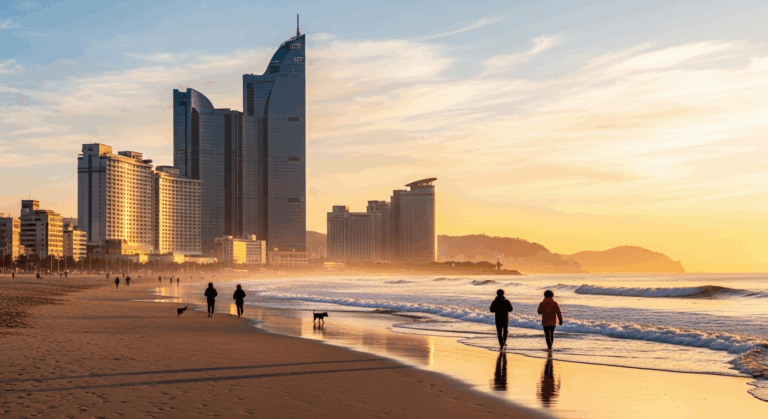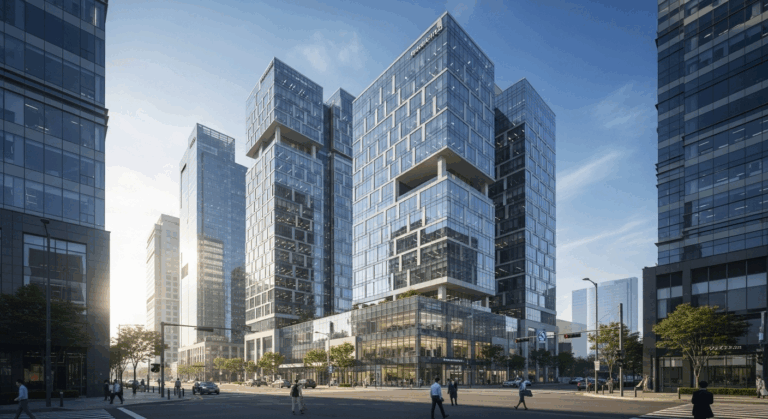When you first arrive in Busan, it’s impossible not to wonder about Gwangalli vs Haeundae — the two most iconic beaches in the city.
It’s on every postcard, every YouTube vlog, and every “Top 10 Things to Do in Busan” list.
The long curve of white sand, the endless hotels, the luxury apartments glowing at night — it looks like the perfect definition of a beach city.
So, naturally, that’s where I went every weekend when I first moved here.
I would grab a latte from Starbucks, walk barefoot on the sand, and think: “I live in Busan now.”
Everything felt cinematic — the smell of sunscreen, the sound of street performers, the skyline reflecting in the sea.
But the longer I lived here, the more I realized that Busan wasn’t just one kind of story.
Because when I started hanging out with locals, I noticed they didn’t go to Haeundae much.
Instead, they’d say, “Let’s meet in Gwangalli.”
At first, I thought it was just convenience — closer to downtown, fewer tourists.
But after spending a few evenings there, I understood what they meant.
Gwangalli wasn’t trying to impress anyone. It wasn’t loud or dramatic. It was quieter, humbler, and somehow more honest.
That’s when I learned the real question isn’t “Which beach is better?”
It’s “What kind of Busan do you want to experience?”
So, in this local guide, let’s talk about Gwangalli vs Haeundae — not as a travel checklist,
but as two different ways of living by the same sea.
1️⃣ Gwangalli vs Haeundae – The Vibe: Same Ocean, Two Different Lives
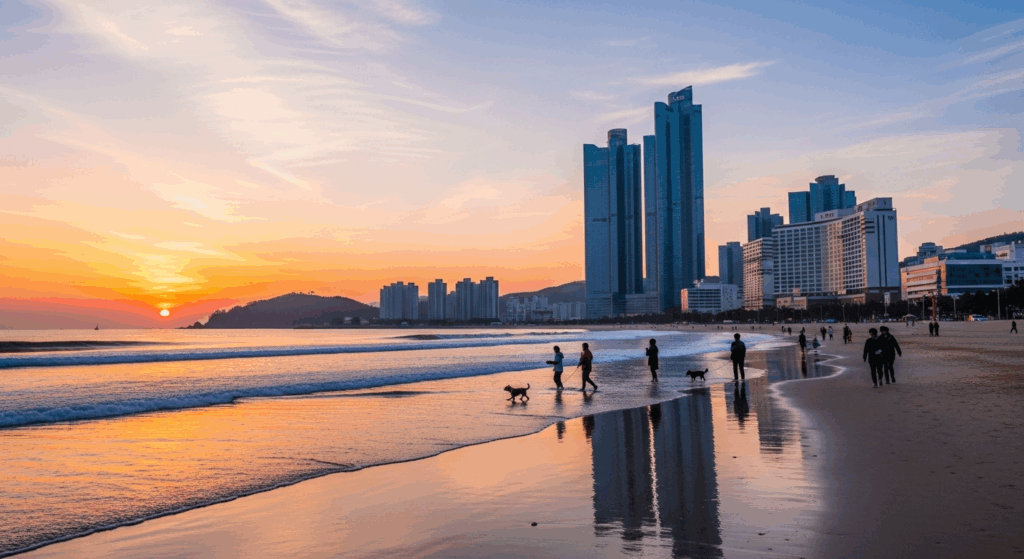
If Haeundae were a person, it would wear a white shirt freshly ironed, sunglasses on even when it’s cloudy. It’s elegant, glamorous, and never out of the spotlight.
Walking along Haeundae Beach feels like stepping into a commercial — people posing, cameras flashing, music from cafés spilling onto the boardwalk.
There’s an undeniable thrill here: a mix of salt air and ambition.
You feel it in the crowd’s energy, in the confidence of people who’ve come from all over the world to see this beach.
But it’s also exhausting sometimes. You can’t really disappear in Haeundae; you’re always part of the show.
That’s why locals say, half-jokingly,
“Haeundae is where we take our friends from Seoul — not where we go ourselves.”
Now, Gwangalli — that’s a different kind of friend.
It’s the one who texts, “Beer after work?” and means it.
The one who doesn’t care if you’re still wearing office clothes or slippers.
The one who just wants to sit near the water and talk about life.
There’s a softness to Gwangalli.
The sound of waves mixes with indie music from nearby cafés.
The view of Gwangan Bridge feels like a heartbeat — slow, steady, glowing.
And even when the beach is full, it doesn’t feel crowded. It feels shared.
If Haeundae is a stage, Gwangalli is a living room.
That’s the real difference Busan locals feel, even if they never say it out loud.
2️⃣ Gwangalli vs Haeundae – What Locals Really Think When They Visit
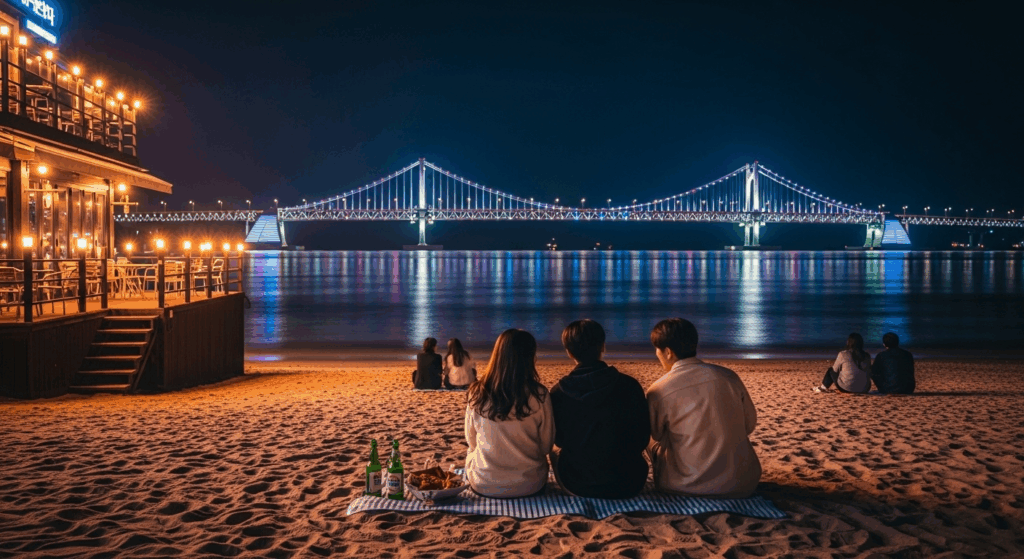
When people visit Haeundae, they imagine rooftop cocktails or fancy brunch by the sea.
But for locals, Haeundae is more like a morning ritual.
They walk the Dongbaek Island Trail for quiet moments before the city wakes up,
or grab fishcake soup at Haeundae Market, chatting with old vendors who’ve been there since before the hotels arrived.
The magic hour is around 8 a.m. — before the sunscreen crowd shows up.
You can hear the waves more clearly, and sometimes, if you stand still enough, you can smell the seaweed drying in the wind.
Gwangalli, though, belongs to the evening.
It’s when office lights start to fade and the bridge slowly lights up that the beach feels alive.
Groups of friends gather on the steps with convenience store beers, laughing about work.
Musicians set up near the sand, playing soft acoustic songs.
And if you walk along the main street, every café feels like it was built for one thing — to give you a perfect view of that bridge.
Local favorites include Cafe de Lapis for its calm atmosphere and Ssongjang Makgeolli Bar for late-night comfort food.
But the truth is, it doesn’t really matter where you sit — because here, the view is the experience.
That contrast — the difference between showing off and slowing down — perfectly explains why locals always compare Gwangalli vs Haeundae when talking about where to spend the weekend.
3️⃣ Getting There & Moving Around (What locals actually do)
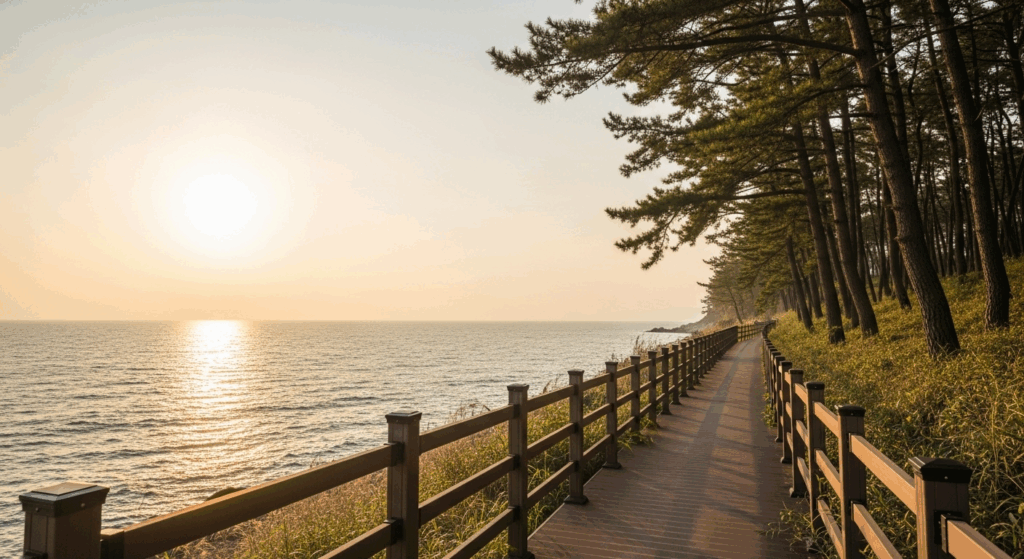
One reason locals often debate Gwangalli vs Haeundae is simple: how easy each beach fits into everyday life.
Haeundae
- Easiest way: Metro Line 2 → Haeundae Station (Exit 3 or 5), then about a 7–10 minute walk to the beach.
- On weekends, the road in front of the beach gets busy because of tourists, hotel guests, and buses dropping off tour groups. Locals who drive sometimes avoid this time because parking lots near the beach fill up quickly and can be pricey.
- That’s why many Busan people visit Haeundae either early in the morning (for a walk on Dongbaek Island) or for a specific plan (hotel brunch, rooftop, meeting a friend staying in Haeundae).
Gwangalli
- Also on Metro Line 2 → Gwangan Station (Exit 3 or 5), but the walk is shorter and the area is more compact.
- There are many small public parking lots in the back streets, so locals who drive find it less stressful than Haeundae.
- It’s also close to Suyeong and Millak areas, so people can have dinner somewhere else and then “end the night” in Gwangalli. That’s a very Busan thing to do: move around the coast, not stay in one spot.
So in daily life, locals think like this:
“Haeundae = plan + time.
Gwangalli = anytime.”
That’s why Gwangalli feels more lived-in — it fits into everyday life.
4️⃣ Best Time & Best Photo Spots (Why they look so different)

Even though they’re both beaches, the timing changes the whole vibe.
Haeundae – best in the morning or clear daytime
- In the morning, the sun hits the water from the right angle and the whole bay looks clean, wide, and calm.
- You can walk from Haeundae Beach to Dongbaek Island and take photos of the curved coastline with high-rise hotels behind you — this is the “postcard Busan.”
- Daytime is also best if you want to capture the LCT Tower, Bay 101, and the luxury side of Busan. Haeundae says: “This is Busan as a global city.”
Gwangalli – best at sunset and blue hour
- Gwangalli is fine in the daytime, but it becomes magical when Gwangan Bridge lights up.
- The light reflects on the water, cafés turn on their warm lights, and suddenly your photo looks cinematic even with a phone.
- Terraces, balconies, and even the beach steps become photo spots. You don’t even have to pose — just sit with a cup of coffee and the background does the job.
- That’s why locals pick Gwangalli for dates, small meetups, or just “I need to breathe near the water.”
So visually:
- Haeundae = wide, bright, luxury, daytime city-beach
- Gwangalli = cozy, romantic, lived-in, night coastline
5️⃣ Places to Visit Around Each Beach (Local-style picks)
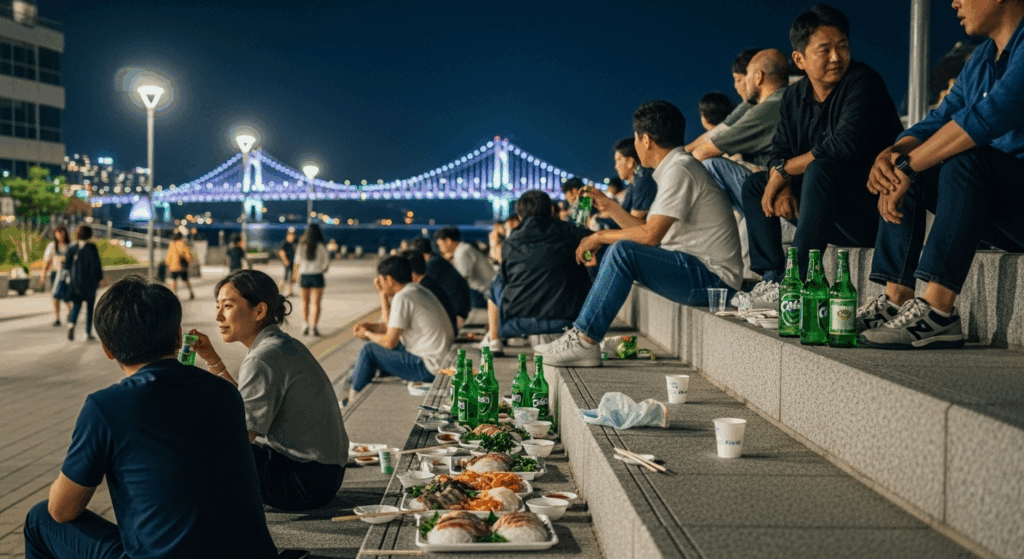
You said “not just restaurant lists,” so here are places that show the character of each beach. These are places Busan people actually take friends to, not just tourist traps.
Haeundae side
- Dongbaek Island (Dongbaekseom)
- Why: This is where locals go to remember that Haeundae is still a seaside town, not just hotels. The coastal trail is quiet, you get sea + pine trees + city view in one walk, and it’s great in every season.
- What to do: Walk the loop, stop at the APEC House, take photos of the curved Haeundae beach from the end of the trail.
- Busan X the SKY (in the LCT tower)
- Why: This is the “special day” spot even for locals. If someone from abroad is visiting, or it’s a birthday/anniversary, Busan people will pick this to show how modern Haeundae has become.
- What to do: Go near sunset to see the coastline turn gold → blue → night.
- Haeundae Traditional Market
- Why: It balances out the fancy side of Haeundae. Locals love this because you can get warm street food, fish cakes, tteokbokki, sugar-filled Korean pancakes, all within walking distance from a luxury beach.
- What to do: Grab snacks here and take them back to the beach.
Gwangalli / Millak side
- Gwangalli Beachfront Walk
- Why: This is the “everyday” Gwangalli. Cafés, bars, dessert shops, and small boutiques all face the sea. You don’t have to decide anything — just walk, feel the sea wind, and sit wherever looks nice.
- What to do: Go right before sunset so you can see the beach in daylight and stay until the bridge is lit.
- Millak Waterside Park (near the raw fish center)
- Why: This is one of those places that doesn’t look like much on a map, but locals love it. You buy sashimi or chicken nearby, sit on the steps facing the water, and eat with a view. Very Busan, very casual.
- What to do: Buy food from Millak Raw Fish Town, bring it out, and eat with paper cups + beer. No one rushes you, and you still see the bridge.
6️⃣ Food & Drinks Locals Actually Like There
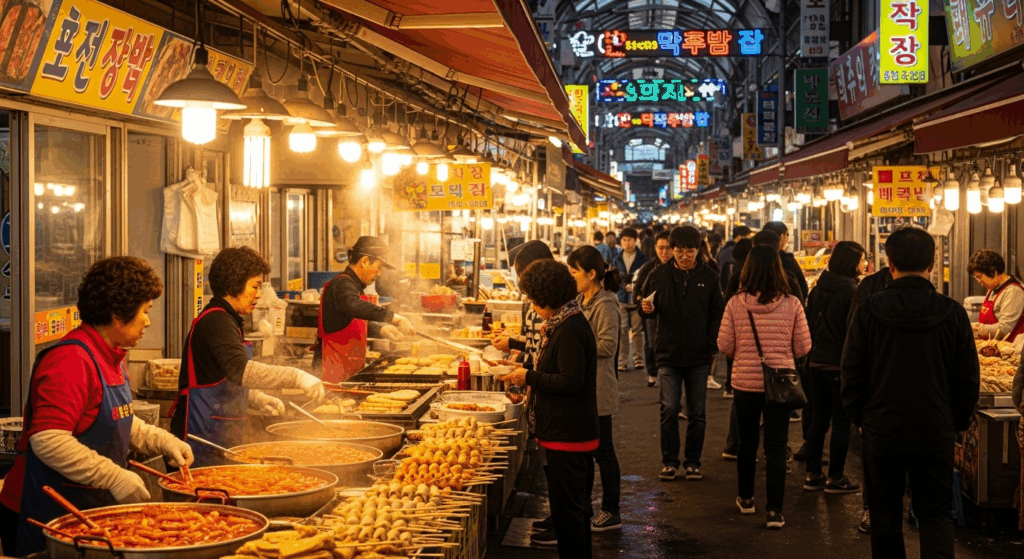
(You asked for “Naver 1,000+ reviews, high rating” style — I can’t pull the exact numbers here, but I’ll list places that are widely talked about among locals and visitors, and that match each beach’s personality.)
Around Gwangalli
- Millak Raw Fish Town (민락회센터)
- Why chosen: It’s affordable, fresh, and has the “eat with the sea right there” feeling. Locals bring friends here to show what Busan seafood culture actually feels like — informal but great.
- Vibe: Not fancy, but fun. You choose your fish downstairs and eat upstairs or take it out to the park.
- A beachfront café with terrace (e.g. Cafe de Lapis / Waveon Gwangalli)
- Why chosen: Gwangalli = café + view. Locals don’t always want a full meal — sometimes just a good seat to watch the bridge. These cafés are popular because they let you stay, talk, and enjoy the skyline.
- Vibe: Slow, photo-friendly, no pressure.
- Casual pub / chicken + beer on the beach
- Why chosen: A very Busan-local way to enjoy Gwangalli is not a restaurant at all — it’s ordering fried chicken or convenience-store beer and eating it right on the sand. It’s cheap, social, and has the best view in the city.
- Vibe: Students, couples, coworkers — everyone mixes here.
Around Haeundae
- Haeundae Market street-food spots
- Why chosen: Even locals who can afford hotel dining still come here because it’s nostalgic and lively. You can grab skewers, fish cake, or hotteok and walk back to the beach.
- Vibe: Lively, local voices, smells of food — good contrast to the luxury hotels.
- A bistro / wine bar behind the main beach road (like Maison-style small restaurants)
- Why chosen: Haeundae has many pretty-but-expensive places on the main road, but locals often step one block inside to quieter spots. These places have better conversations, less noise, and still give you the Haeundae “evening out” feeling.
- Vibe: Date night, small gatherings, more adult than touristy.
- Thursday Party Haeundae (or similar expat bars)
- Why chosen: If the reader is a foreigner living in Busan, they’ll probably want at least one place where they can meet other foreigners. Haeundae has a higher chance of that than Gwangalli.
- Vibe: International, casual, good for solo travelers.
🌅 What “the Real Busan” Feels Like

After all these years of living here, I’ve learned something funny about Gwangalli vs Haeundae — Busan people don’t see it as competition, but as two moods of the same sea.
They move between them depending on what they need.
If you want to feel inspired, see the skyline, and feel like you’re standing in a movie, go to Haeundae.
It’s bold, confident, and polished — the kind of place where Busan shows the world what it’s capable of.
But when the weekend ends and life goes back to normal, we return to Gwangalli.
We sit on the sand with our shoes off, coffee in hand, and the Gwangan Bridge glowing quietly above the sea.
There’s no rush, no show — just small talk, sea breeze, and that familiar Busan rhythm.
That’s why when people ask me, “Which beach do locals prefer?” I always smile and say:
“Tourists love Haeundae.
But locals live at Gwangalli.”
Because in Busan, the sea has two faces — one that shines for the camera, and one that listens when you’re tired.
Both are beautiful. It just depends which one you need today.
Learn more about Busan’s coastal attractions on VisitKorea official site.


